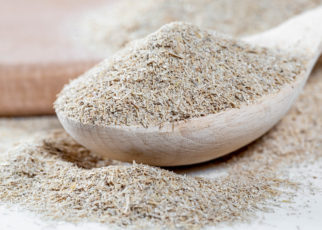Wheat bran is one of the three layers of the wheat kernel. Bran was traditionally considered to be nothing more than a byproduct that was separated from the cereal during the milling process. However, the benefits of Wheat bran were highlighted by a few people, and it is now used widely for its various health benefits.
Most of these benefits of wheat bran are associated with ample minerals, fiber, and plant compounds nutrition available in Wheat bran.
It has a very impressive nutritional profile that reduces the risk of many chronic diseases and improves your overall health. Today, we will be talking about everything you need to know about wheat bran. So, without further ado, let’s get to it.
What is Wheat Bran?
There are a total of three parts of a wheat kernel: the germ, endosperm, and the bran.
The wheat kernel’s outermost layer is called wheat bran, and it is full of fiber and essential nutrients. The Wheat bran is separated from the wheat kernel as a byproduct during the process of milling.
It is popularly used to add texture and has a nutty, sweet flavor. It can also be used as a full-bodied taste to baked goods like muffins and bread.
Related: What is Rice Bran Oil? – Benefits, Nutrition
Nutritional Profile
As mentioned above, there are a lot of essential nutrients packed in wheat bran. One 29-gram (Half-cup) serving of wheat bran packs:
- Phosphorus: 294 mg
- Magnesium: 177 mg
- Iron: 3.05 mg
- Potassium: 343
- Vitamin B6: 0.4 mg
- Niacin: 4 mg
- Riboflavin: 0.15 mg
- Thiamine: 0.15 mg
- Dietary fiber: 12.5 grams
- Carbohydrates: 18.5 grams
- Protein: 4.5 grams
- Saturated fat: 0.2 grams
- Fat: 1.3 grams
- Calories: 63
Despite having only an average amount of copper and zinc, it packs more than the DV of manganese and more than half of the Daily Value of selenium. Despite providing all of these nutrients, wheat bran is super low in calories.
There are only 63 calories in about a half cup of Wheat bran, which is comparatively very low as per the nutrients packed.
Moreover, it is low in saturated fats, total fat, and cholesterol and high in plant-based protein. In half a cup (29 grams), there are about 5 grams of protein.
But most importantly, wheat bran is a great source of fiber content. You are set to get about 99 % of the DV of fiber, which is 13 grams, in half a cup of wheat bran that packs 29 grams.
Wheat Bran Benefits
Wheat Bran is a nutrition-dense food with some very appealing health benefits.
May Promote Heart Health
There have been numerous studies that suggest that consuming diets that are high in fiber can leads to a massive decrease in the risk of heart disease.
Another study suggested that consumption of wheat bran cereal every day for three weeks leads to a massive reduction in total cholesterol levels. Moreover, there was no reduction in “good” HDL cholesterol.
Triglycerides are a kind of fat present in your blood that, if elevated, is linked with a larger risk of heart disease. Continuous research has also suggested that consuming diets that have a lot of fiber content can reduce blood triglycerides up to an extent.
So, the daily consumption of wheat bran may help you prevent heart disease by increasing your total intake of fiber.
May Help Prevent Certain Cancers
There has been quite a lot of evidence and studies suggesting that wheat bran may potentially assist in preventing some types of cancers. One of which is colon cancer, the third most common cancer in the world.
Several researches and studies conducted on both mice and humans have suggested the potential of wheat bran in reducing the risk of development of colon cancer.
Moreover, studies reflect that wheat bran can impair the development of tumors in the colon of humans more consistently than other grain sources that are high in fiber content, like oat bran or rice bran.
However, we are not implying that the fiber content of wheat bran is the only reason it effectively reduces this risk. Other major contents of wheat bran – such as natural antioxidants, like phytic acid and photochemical lignans play their role as well.
Promotes Digestive Health
There is a lot of ways in which wheat bran positively affects your digestive health. It is a rich source of insoluble fiber, which includes bulk to your stool and promotes the swift movement of stool.
The insoluble fiber can be very effective in promoting digestive health by smoothing the stool movement and preventing or relieving constipation.
Furthermore, a study showed that consumption of wheat bran on a regular basis can help you get rid of other digestive symptoms like discomfort and bloating, and is even more efficient in adding fecal bulk when compared to other forms of insoluble fiber like certain vegetables and fruits, and oats.
Potential Downsides
Despite being a nutrient-dense food and having many health benefits, there are a few downsides of consuming excess wheat bran.
Contains Phytic Acid
It is a very common compound that is found in all plant seeds, and wheat germs are no exception. Phytic acid is sometimes responsible for hampering the body’s ability to absorb some essential minerals like iron, calcium, and magnesium.
Therefore, your body will not be able to take full benefit of these minerals present in your diet if you are also consuming wheat bran cereal that is high in phytic acid.
This is the reason why people often refer to phytic acid as an ant nutrient. However, if you are sticking to a balanced diet, you must not worry about this. But yes, if you are regularly consuming foods that are high in phytic acid, you may notice in deficiency of these minerals over a period of time.
Contains Fructans
Fructans are a kind of oligosaccharide, a carb that is formed through a chain of fructose molecules with a glucose molecule at the end.
This type of chain carbohydrate ferments in the colon as it is indigestible. This fermentation process can lead to various digestive side effects like diarrhea, abdominal pain, belching, and gas.
People who are already suffering from irritable bowel syndrome (IBS) are more likely to be affected.
Contains Gluten
There is a large number of people that are not able to digest gluten without feeling adverse side effects. Wheat bran contains a family of proteins called gluten that have devastating effects on people that are intolerant to gluten.
Conclusion
Wheat bran is the outermost protective layer of the wheat kernel that is separated in the milling process as a product. It packs a lot of essential nutrients that make it a very healthy cereal. Some of the benefits of consuming wheat bran include a reduction in the risk of certain cancers, better digestive, and heart health.
Along with these benefits, there are certain downsides of wheat bran that must be taken into consideration, like Gluten, Fructans, and Phytic acid.
You can easily add it do your daily diet as it is just like any other morning cereal you will see on Wal-Mart.
We hope the article was helpful to you. You can visit the related section to see more such articles. You are also welcome to share your thoughts using the comments section below.
Discover more from Thenewsdoor
Subscribe to get the latest posts sent to your email.





